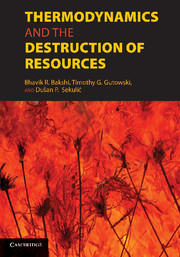Book contents
- Frontmatter
- Contents
- Contributor List
- Foreword by Herman E. Daly
- Foreword by Jan Szargut
- Preface
- Introduction
- PART I FOUNDATIONS
- 1 Thermodynamics: Generalized Available Energy and Availability or Exergy
- 2 Energy and Exergy: Does One Need Both Concepts for a Study of Resources Use?
- 3 Accounting for Resource Use by Thermodynamics
- PART II PRODUCTS AND PROCESSES
- PART III LIFE-CYCLE ASSESSMENTS AND METRICS
- PART IV ECONOMIC SYSTEMS, SOCIAL SYSTEMS, INDUSTRIAL SYSTEMS, AND ECOSYSTEMS
- Appendix: Standard Chemical Exergy
- Index
- References
3 - Accounting for Resource Use by Thermodynamics
Published online by Cambridge University Press: 01 June 2011
- Frontmatter
- Contents
- Contributor List
- Foreword by Herman E. Daly
- Foreword by Jan Szargut
- Preface
- Introduction
- PART I FOUNDATIONS
- 1 Thermodynamics: Generalized Available Energy and Availability or Exergy
- 2 Energy and Exergy: Does One Need Both Concepts for a Study of Resources Use?
- 3 Accounting for Resource Use by Thermodynamics
- PART II PRODUCTS AND PROCESSES
- PART III LIFE-CYCLE ASSESSMENTS AND METRICS
- PART IV ECONOMIC SYSTEMS, SOCIAL SYSTEMS, INDUSTRIAL SYSTEMS, AND ECOSYSTEMS
- Appendix: Standard Chemical Exergy
- Index
- References
Summary
Motivation
Given the crucial role played by natural resources in any economic activity, many efforts have focused on accounting for their contribution to individual industrial processes and broader life cycles. These include traditional engineering approaches such as pinch [1, 2], exergy (see Chap. 2) and exergoeconomic analysis (see Chap. 15 by Tsatsaronis), that are used extensively for equipment and process design. Because environmentally conscious decisions require consideration of a broader boundary that accounts for the whole life cycle, many of these approaches have also been extended from the equipment to the life-cycle scale.
Most methods that analyze the life cycle of industrial products focus on emissions and their impact and the use of nonrenewable resources such as fossil fuels and minerals. More recent efforts also account for the role of land, soil, etc. [3]. Although sophisticated methods have been developed and standardized for assessing the life-cycle impact of emissions [4, 5], methods for resource accounting have been lagging behind. Even with many resource aggregation methods developed over the past several decades, consensus about the most appropriate method is still nonexistent. In addition, most resource accounting methods fail to consider some of the most critical resources, namely, ecosystem goods and services, that sustain all life on Earth. This “natural capital” includes provisioning services such as minerals, fossil fuels, water, biomass; supporting services such as biogeochemical cycles, carbon sequestration, pollination; regulating services such as regulation of pests, climate, and soil fertility; and cultural services.
- Type
- Chapter
- Information
- Thermodynamics and the Destruction of Resources , pp. 87 - 110Publisher: Cambridge University PressPrint publication year: 2011
References
- 3
- Cited by



